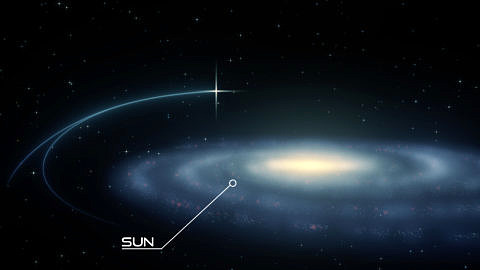Hypervelocity binary star puzzles astronomers

A traveller from a distant galaxy
Could the star with the cryptic name PB 3877 be an intruder from a distant galaxy? FAU astronomers who – in collaboration with colleagues at the California Institute of Technology (USA) – discovered the star and have observed it closely for year think this may be the case. However, it is not just the origin of the star that is puzzling to the researchers.
PB 3877 races through the outer edge of our galaxy at around around two million kilometres per hour – fast enough, the researchers believe, to overcome the gravitational pull of the Milky Way and leave the galaxy. It is one of the approximately two dozen hypervelocity stars that are currently known.
Does PB 3877 come from another galaxy?
The animation below by Thorsten Brand, a research associate at the Institute of Astronomy, shows the possible paths the binary star PB 3877 may have taken to reach its current position. Does it come from a different galaxy at the edge of the Milky Way or was it catapulted out from the centre of our galaxy?
The most remarkable thing about PB 3877 is not its speed but the fact that it is a binary star, while all other known hypervelocity stars are single stars. It is this discovery that the researchers are perplexed by. ‘We cannot image a mechanism that would enable a binary star system to be accelerated to such a high speed without destroying it,’ explains FAU astronomer Dr. Peter Nemeth. Researchers previously assumed that the massive black hole at the centre of the Milky Way was the motor that accelerated stars to such high velocities. However, it is generally accepted that when a binary star approaches a black hole, the forces at work there tear it apart, pulling one star into the centre of the black hole and catapulting its companion out into the universe.
Calculations of the star’s path by Eva Ziegerer, a doctoral candidate at FAU, also contradict this theory. ‘It is highly likely that PB 3877 has never been anywhere near the centre of the galaxy,’ she says.
The researchers have also ruled out other acceleration scenarios such as collisions between stars or supernova explosions, as these events would also tear the binary system apart. For this reason, the team of researchers led by Peter Nemeth think that PB 3877 could be an intruder from another galaxy. ‘There are many stellar streams at the edges of the galaxy that are probably the remains of dwarf galaxies,’ Peter Nemeth says. The binary star may have found its way to our galaxy from there, having gradually been accelerated.
Current data does not allow PB 3877 to be clearly allocated to a specific stellar stream, meaning that its origin – and its future – remain unknown. However, this star’s future path could provide researchers with new information about the nature of the Milky Way. This is because whether the binary star leaves it or not depends on the mass of the dark matter in our galaxy. ‘Hypervelocity stars therefore give us an opportunity to learn more about the dark matter in the universe,’ Peter Nemeth explains.
The researchers recently published their findings in The Astrophysical Journal. Nemeth, P., et al. 2016, ApJL, 821, L13, iopscience.iop.org
Further information:
Dr. Peter Nemeth (English)
Phone: +49 951 9522219
presse@fau.de
Eva Ziegerer (German)
Phone: +49 951 9522220
eva.ziegerer@sternwarte.uni-erlangen.de